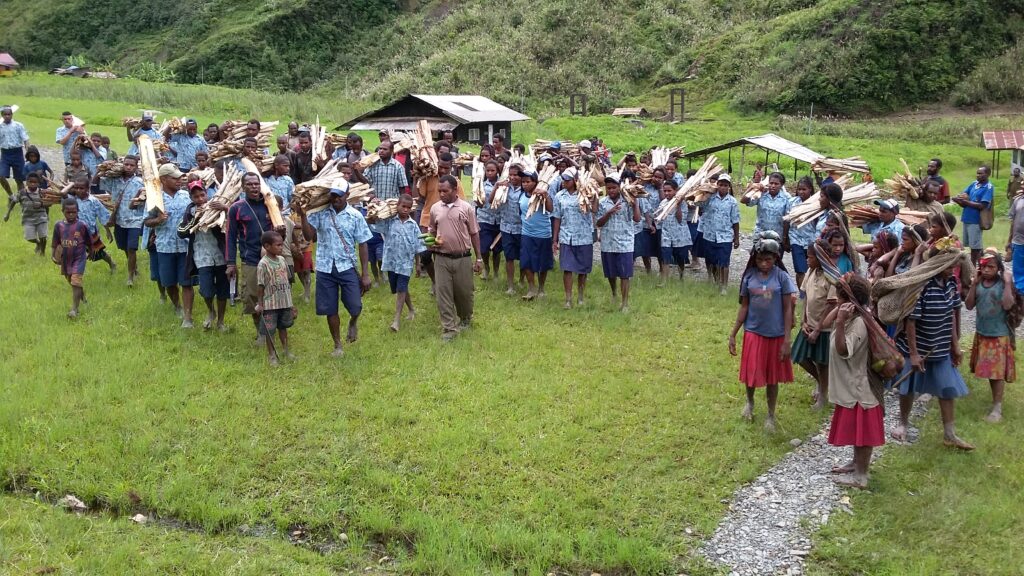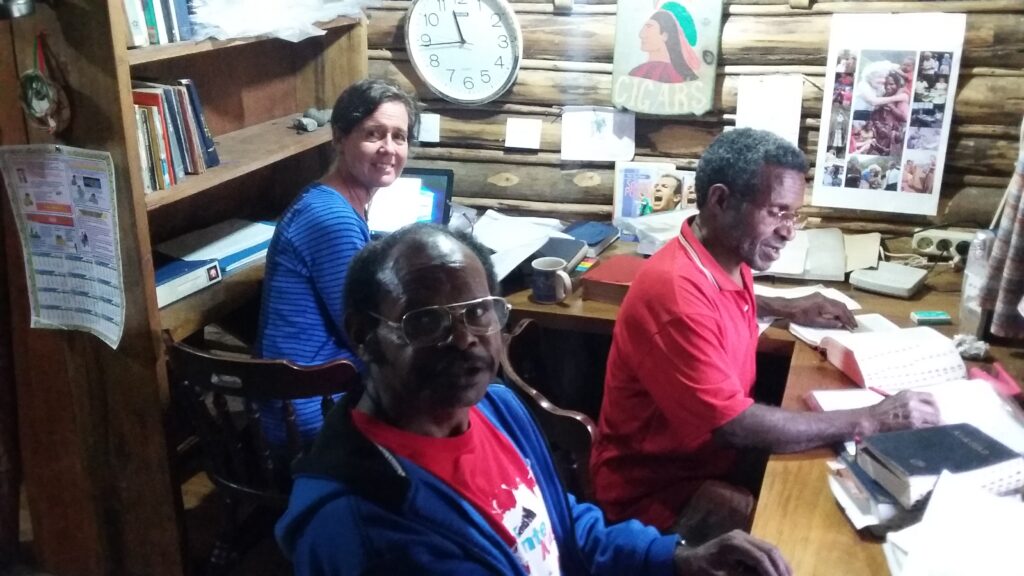Today’s post is written by a Myrna Maxey, a CAMA worker serving in Papua, Indonesia. She and her husband Buzz began the Papua United Football Club as an HIV/Aids awareness program in 2011. For the past seven years, they have also partnered with two local pastors translating the Bible into Ngalik. This is a recent story from that project.
Grabbing two broom handles from behind our translation cabin door, I quickly put them on either side of the table near the fireplace.
“It’s sorta like this,” I said to the Ngalik Bible translators, Amos and Enos, working on corrections to their Old Testament translation.
Sea Cows
Amos had just asked about the sea cow hides in the Tabernacle. You can imagine how hard this was to describe! We had spent many hours trying to research the Tabernacle—all without the internet—in our remote village in Indonesia.
“In the first room with walls of cloth there is a table. It’s right about here,” I said taking unshelled “eremna” nuts and setting them on the table. “Then there’s this place for light here on the left.”
My husband Buzz took a candle off the fireplace mantel.
“In front of the curtain is the square alter where Aaron burns incense. This tall incense box had rings where poles—or broom handles—were placed so it could be carried. All this stuff got packed up by Aaron’s sons and covered with several colors of cloth and sea cow hides,” I said. “Do you understand it better?”
Amos and Enos nodded.
A Connection
“Ok, then there was this beautiful blue, crimson, and purple curtain that hung right here between this room and that room,” Buzz explained.
As we described the colors, they choose the colors they knew: “weepeken” (purple from a berry), “boru” (the reddish color from iron ore), and “bogor lalu” (the color of blue sky). Buzz and I then tried to carefully describe the sacred room where the ark was placed.
“This is where Aaron would come reverently once a year with his special priestly tunic to make atonement for sins. But guys, that was the Old Testament,” Buzz said. “Jesus came—”
“Yes, this is it!” Enos jumped in. “This is what is talked about in Hebrews 9-10! I remember translating it years ago. We don’t need to bring sacrifices anymore and go through all these ceremonies. We used to do that in our own culture with pigs for ancestral spirits.”
“In the Old Testament there was blood that needed to be sprinkled again and again, but then Jesus came. His laws are now in our hearts, no longer on those tablets of stone. So we can enter this most Holy Place, confidently any time to receive His forgiveness. It was Jesus’s death that tore this dividing curtain in two.”
There was this short silence as the rain got stronger on our aluminum roof. We sat back in our chairs, quieted by the poignant moment. Amos made the traditional Ngalik clicking sound with his mouth to show amazement.
“Yes, that’s it,” Buzz said. “That’s the truth of all this. We no longer need to try to keep God happy with our sacrifices, but we can receive the grace He offered us on the cross.”
Offerings
Later in the week, I was reading Exodus 35 where the Israelites came with willing hearts to present offerings for those working on the Tabernacle. All those “who were moved” brought gold, acacia wood, gems, or even goat hair. That same day as Amos, Enos, and I were back to work in our translation cabin, Buzz rushed in.
“People are dancing and singing outside with gifts to give towards the translation project,” Buzz said excitedly. “Amos and Ernos, they want to support your work on the Scriptures.”

In a matter of a few minutes, there was an excited group of 200 men, women, and children singing in our yard with their offerings of firewood, sweet potatoes, “eremna,” squash, and sugar cane. It was a true outpouring of generosity and support for Amos and Enos who have worked on the translation project for seven years.
It was moving to hear the district leader pray a prayer of blessing over Amos and Enos and their wives. But I could not longer contain my tears when a small group of children and their pastor unloaded their mud-covered gifts from their net bags. They had walked for almost four hours to present their gifts. What an amazing demonstration of support these people were giving for the completion of God’s Word in their heart language.

As I walked into the house I realized this is one of the main reasons we are here. We sincerely desire that young girls and boys, older men and women will, like us, understand more deeply the incredible free gift the Lord gave us.
Jesus came and paid for our sins so that we can live forgiven and in His grace.
We never did find a picture of a sea cow in any of our books, and frankly, I still don’t know what one looks like. But way more important than that, Amos, Enos, Buzz, and I understand more deeply the grace of God.
